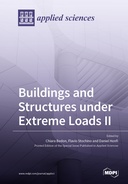Explore

Buildings and Structures under Extreme Loads II
0 Ungluers have
Faved this Work
Login to Fave
Exceptional loads on buildings and structures are known to take origin and manifest from different causes, like natural hazards and possible high-strain dynamic effects, human-made attacks and impact issues for load-bearing components, possible accidents, and even unfavorable/extreme operational conditions. All these aspects can be critical for specific structural typologies and/or materials that are particularly sensitive to external conditions. In this regard, dedicated analysis methods and performance indicators are required for the design and maintenance under the expected lifetime. Typical issues and challenges can find huge efforts and clarification in research studies, which are able to address with experiments and/or numerical analyses the expected performance and capacity of a given structural system, with respect to demands. Accordingly, especially for existing structures or strategic buildings, the need for retrofit or mitigation of adverse effects suggests the definition of optimal and safe use of innovative materials, techniques, and procedures. This Special Issue follows the first successful edition and confirms the need of continuous research efforts in support of building design under extreme loads, with a list of original research papers focused on various key aspects of structural performance assessment for buildings and systems under exceptional design actions and operational conditions.
This book is included in DOAB.
Why read this book? Have your say.
You must be logged in to comment.
Rights Information
Are you the author or publisher of this work? If so, you can claim it as yours by registering as an Unglue.it rights holder.Downloads
This work has been downloaded 84 times via unglue.it ebook links.
- 84 - pdf (CC BY) at Unglue.it.
Keywords
- Adhesives
- aeroelastic experiments
- algebraic polynomials
- analytical model
- artificial neural network (ANN)
- balau wood
- blast analysis
- blast loads
- blast scenario
- bonded-in rod (BiR) connections
- Boundaries
- bracing system
- burger model
- cable-stayed bridge
- catenary mechanism
- cathedral
- cohesive zone modelling (CZM) method
- component-based models
- correlation field
- cracks
- Creep
- cross-arm
- damage level
- differential equation of motion
- double-span assemblies
- Ductility
- experimental uncertainty
- Experiments
- findley’s power law model
- finite element analysis
- finite-element (FE) method
- foundation rehabilitation
- fracture modes
- Friction
- History of engineering & technology
- inclined self-tapping screws (STSs)
- initial stiffness
- jacked-in piles
- lap-splice
- Legendre–Galerkin matrix (LGM) method
- lightning strike
- linear elastic fracture mechanics (LEFM)
- LS-DYNA
- masonry
- mode number
- moisture
- moment-rotation relation
- multi degree of freedom (MDOF)
- multi-column pier
- n/a
- non-destructive test
- partial collapse
- plastic hinge
- prediction model
- progressive collapse
- prototype abutment
- push-out (PO) test setup
- reinforced concrete column
- roof structure
- scour
- seismic behavior
- sensitivity analysis (SA)
- sensitivity study
- single degree of freedom (SDOF)
- singular value decomposition
- slab-column joints
- social disaster
- soil injection
- steel beam-to-column connections
- steel truss
- stiffness degradation
- surcharge load
- Technology, engineering, agriculture
- Technology: general issues
- timber-to-timber composite (TCC) joints
- top-seat angle connections (TSACW)
- transmission tower
- transverse reinforcement
- ultimate moment capacity
Links
DOI: 10.3390/books978-3-0365-3871-6Editions

